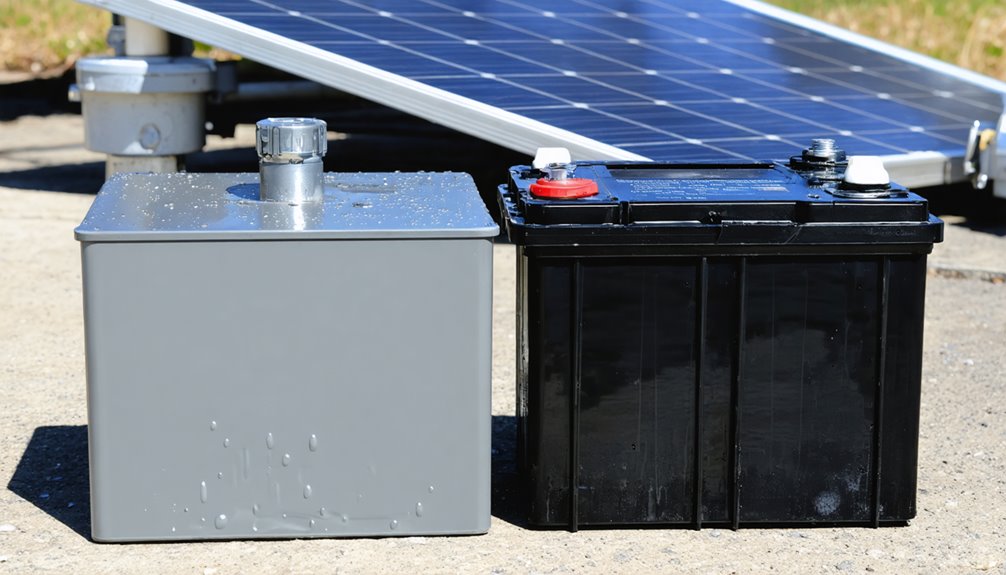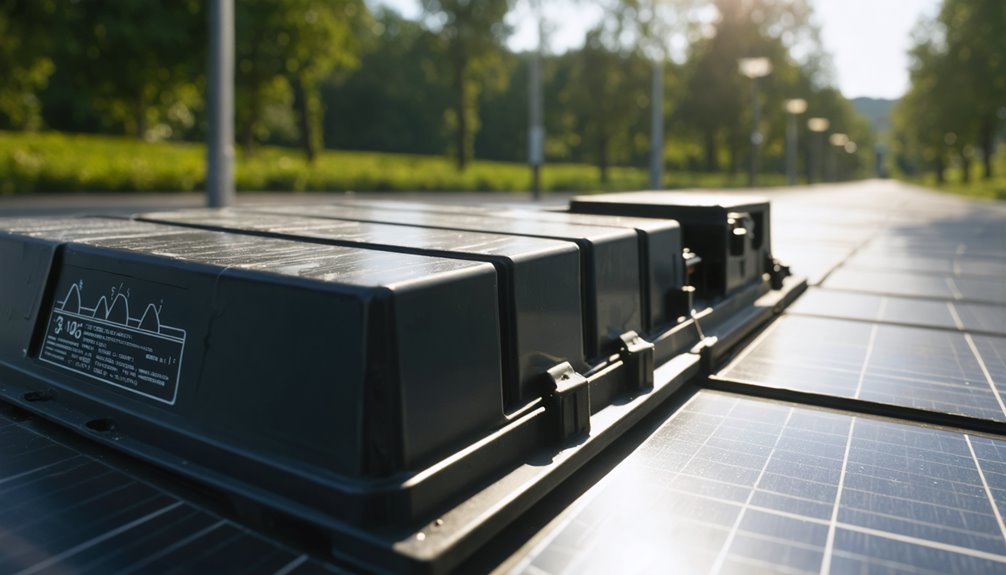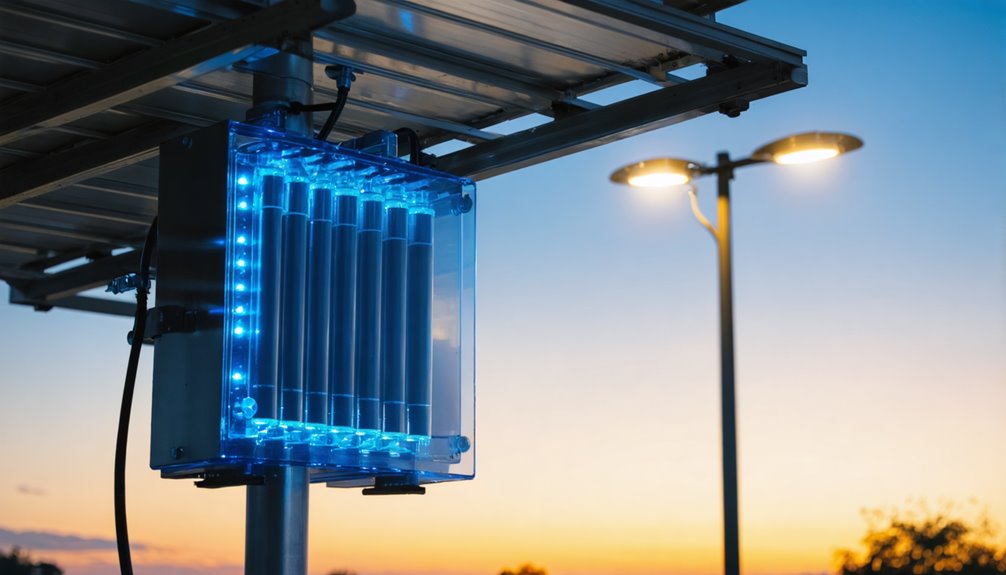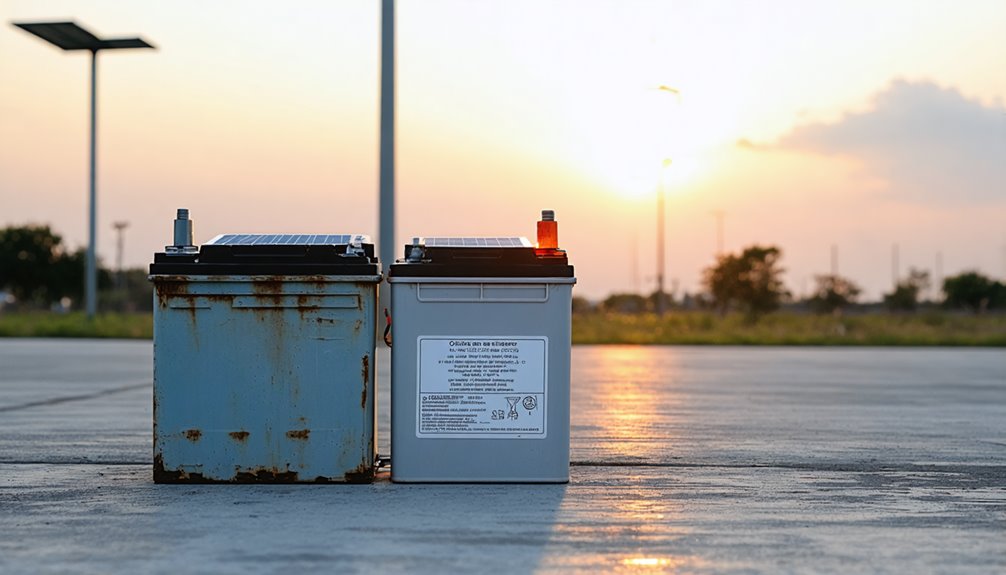You’re seeing solar street lights pop up everywhere, but how long do their batteries actually last? The answer depends on what’s inside them. Some batteries run for just three years while others keep going for a decade. Your neighborhood’s street lights might use different battery types than your home solar system. The technology behind these power sources continues to evolve rapidly.
Average Lifespan of Different Solar Battery Types
When you’re choosing a solar battery system, you’ll find that different battery types last for different amounts of time. Lead-acid batteries have an average lifespan of 3-5 years. They’re cheaper but won’t last as long as other options. Gel batteries do slightly better at 4-6 years. They handle deep discharges well, making them good for solar street light batteries.
Lithium-ion batteries last much longer at 5-10 years. They can handle about 800 charge cycles before losing significant capacity. The longest-lasting option is lithium iron phosphate batteries. They’ll give you 6-10 years of use with 1,500-2,000 cycles.
These numbers show typical performance for solar batteries. Your actual results depend on how you use them and where they’re installed. Unlike regular batteries, rechargeable solar batteries can harness and store energy from the solar panel throughout their lifespan.
Lead-Acid Battery Performance in Solar Applications
Although lead-acid batteries cost less than other solar battery types, they don’t perform as well over time. You’ll find these batteries last about 3 to 5 years in solar applications. Their cycle life typically reaches 300 to 500 deep discharges before they need replacement.
Lead-acid battery performance drops when you discharge them too deeply. Experts recommend keeping the depth of discharge between 20% and 40% to improve longevity. These batteries need regular maintenance to work properly. You’ll need to check water levels and clean terminals frequently.
The batteries work well for solar lights because they have low self-discharge rates. This matches the partial discharge patterns common in solar lighting systems. However, their efficiency decreases considerably when you discharge them too deeply. When your lead-acid batteries fail, following proper replacement procedures ensures your solar lighting continues functioning efficiently.
Gel Battery Longevity and Deep Cycle Capabilities
Gel batteries offer better performance than lead-acid batteries, lasting 4 to 6 years in solar applications. You’ll find these maintenance-free batteries handle deep cycle charging exceptionally well. They’re built specifically for solar street lights and similar equipment that needs consistent power. While gel batteries excel in standalone applications, modern lithium-ion technology provides even longer lifespans for residential solar storage systems, often exceeding 10 years of reliable service.
Here’s how gel batteries compare to standard options:
| Feature | Gel Batteries | Standard Lead-Acid |
|---|---|---|
| Lifespan | 4-6 years | 2-3 years |
| Charge-Discharge Cycles | 500-800 | 200-300 |
| Temperature Range | -40°C to 65°C | -20°C to 50°C |
| Maintenance Required | None | Regular water top-ups |
These batteries survive frequent deep discharges without losing capacity. Their sealed design prevents spills and operates safely in extreme temperatures. The technology eliminates water refills completely. That’s why solar installers choose them for remote locations.
Lithium-Ion Battery Cycle Life and Durability

Lithium-ion batteries outlast most other solar battery options on the market today. You’ll find these batteries deliver 500-800 cycles, which means better durability than traditional lead-acid models. Their high energy density lets you discharge up to 75% of the battery’s capacity without damage.
For solar applications, you’re looking at batteries that last 5-10 years. That’s impressive operational longevity compared to other types. The compact design fits easily in tight spaces, making installation simpler for contractors.
These batteries handle heat well. Their thermal stability means they won’t break down quickly in hot conditions. This feature extends their lifespan and maintains performance over time. You’ll see consistent energy output throughout their service life, making lithium-ion batteries a dependable choice for solar energy storage. Major manufacturers like Tesla Powerwall and LG Chem have perfected lithium-ion technology to deliver reliable performance that justifies their premium pricing.
Lithium Iron Phosphate Battery Advantages for Street Lighting
When you’re powering street lights with solar energy, Lithium Iron Phosphate (LiFePO4) batteries deliver exceptional performance. These batteries last 6 to 10 years with 1500 to 2000 deep cycles. You’ll find they’re safer than standard lithium-ion options because they don’t overheat easily. Unlike conventional battery chemistry differences, LiFePO4 technology offers superior thermal stability and longevity for outdoor applications.
| Feature | Performance |
|---|---|
| Long Lifespan | 6-10 years |
| Cycle Life | 1500-2000 cycles |
| Depth of Discharge | Up to 75% |
| Temperature Range | -40°C to 65°C |
| Fire Risk | Very Low |
For solar street lighting, you can use 75% of the battery’s capacity without harming it. They work in extreme temperatures from -40°C to 65°C. You won’t need much maintenance either. These features make LiFePO4 batteries perfect for outdoor lighting systems that must work year-round in any weather.
Flow Battery Technology and Long-Term Performance
While most solar batteries can’t use their full capacity without damage, flow batteries break this rule completely. You can drain them 100% without hurting their lifespan or performance.
These batteries work differently than regular ones. They’re perfect for renewable energy systems and various energy storage applications. You’ll find them lasting over 10 years because they handle thousands of charge-discharge cycles easily.
Flow batteries adapt to different sizes, making them great for solar street lights and bigger projects. They’re more complex and expensive than traditional batteries, though. Scientists are working to make them cheaper and store more energy.
Their long-lasting nature comes from their unique design. Unlike regular batteries that wear out quickly, flow batteries keep going strong year after year.
Impact of Depth of Discharge on Battery Lifespan

You’ll find that depth of discharge plays a major role in how long your solar battery lasts. When you drain a battery more deeply before recharging it, you’re reducing the number of times it can be charged and discharged throughout its life. Different battery types handle this stress differently – lead-acid batteries work best when you only use 20-40% of their capacity, while lithium-ion batteries can handle using up to 75% without wearing out as quickly. For homes with higher daily energy consumption like 30 kWh, managing depth of discharge becomes even more critical to ensure your battery bank maintains its expected lifespan while meeting your power needs.
DoD Effects on Cycles
Battery manufacturers have discovered that how deeply solar batteries discharge directly affects how long they’ll last. When you discharge lead-acid batteries to only 40% capacity, they’ll survive up to 500 cycles. But if you drain them to 80%, they’re limited to 300-500 cycles.
Lithium-ion batteries handle Depth of Discharge better in solar applications. They’ll maintain 500-800 cycles even when you use 75% of their capacity. Some lithium iron phosphate models reach 1,500-2,000 cycles at ideal discharge levels.
The connection between discharge depth and battery lifespan is clear. Shallow discharges mean more cycles. Deep discharges reduce the total cycles you’ll get. This relationship stays consistent across different battery types, though each technology has its own best range.
Battery Type DoD Limits
Different battery types have specific discharge limits that determine their lifespan. Lead-acid batteries work best when you keep their depth of discharge between 20-40%. This limited range helps extend their cycling life. However, lithium-ion batteries can handle much deeper discharges – up to 75% – without significant damage.
When you push lead-acid batteries beyond their recommended limits, you’ll see dramatic effects. Their cycle count can drop to just a few hundred cycles with consistent deep discharging. That’s why the lifespan of solar street lighting systems depends heavily on choosing the right battery type for your discharge needs.
Lithium-ion technology offers more flexibility for applications requiring deeper daily discharges. You’re getting more usable capacity without sacrificing longevity.
Environmental Factors Affecting Solar Battery Longevity

Where you live and how you store your solar batteries can make them last longer or wear out faster. High temperatures speed up battery breakdown, especially for lead-acid types that usually last 3-5 years. Cold weather reduces battery performance too. You’ll see lithium-ion batteries lose power during winter months.
| Environmental Condition | Lead-Acid Impact | Lithium-Ion Impact |
|---|---|---|
| High Temperatures | Severe degradation | Moderate damage |
| Cold Weather | Reduced capacity | Performance drops |
| Coastal/Humid Areas | Component corrosion | Better resistance |
Environmental conditions affect battery longevity in different ways. Frequent deep discharges hurt lead-acid batteries more than lithium types. Coastal areas with salty air can damage battery parts. That’s why proper temperature control and insulation help batteries last longer.
Maintenance Requirements for Extended Battery Life
You’ll need to check your solar batteries regularly to keep them working well for years. Experts say inspections should happen monthly to spot problems like corrosion on battery terminals before they cause damage. When you’re not using batteries, they need proper storage in cool, dry places away from extreme temperatures that can hurt their performance.
Regular Inspection Schedules
When solar street light owners check their batteries twice a year, they’re following maintenance schedules that can extend battery life considerably. These regular inspections help identify problems like corrosion or leakage that hurt ideal performance. During checks, technicians monitor the battery’s charge levels and discharge depths to meet maintenance requirements.
Cleaning battery terminals prevents buildup that disrupts electrical connections. Inspectors also look for physical damage like swelling or wear. These warning signs show when replacement necessary to avoid system failures.
Well-maintained batteries can last up to 10 years. That’s why documenting inspection findings matters. When owners track problems and fix them quickly, they’re protecting their investment. This routine care safeguards the battery lifespan reaches its full potential while keeping the solar lighting system running efficiently.
Proper Storage Conditions
Battery storage conditions play a critical role in determining how long solar batteries last. You’ll find that temperature control matters most for battery longevity. Experts report that cool, dry environments help extend lifespan considerably. High temperatures damage lithium-ion and lead-acid batteries faster than any other factor.
Proper maintenance includes keeping batteries at 40-60% charge during storage. This practice prevents deep discharges that permanently reduce capacity. Insulated enclosures protect batteries from extreme weather and temperature swings.
Regular terminal inspections prevent corrosion buildup that affects peak performance. Manufacturers recommend specific humidity levels for different battery types. Following these storage conditions guidelines helps batteries last years longer than those stored improperly.
Signs Your Solar Street Light Battery Needs Replacement
Although solar street light batteries are built to last, they’ll eventually show signs of wear that signal it’s time for a replacement. You’ll notice your battery for solar street needs attention when lights appear dimmer or won’t turn on at night. These signs your solar street light battery needs replacement include lights shutting off earlier than usual.
Frequent charging and discharging cycles beyond recommended limits damage performance and longevity. Physical problems like swelling, leaking, or corroded terminals mean you must replace batteries immediately. Battery lifespan varies by type. Lead-acid batteries typically last three to five years, while lithium-ion versions work for five to ten years. When batteries exceed these timeframes, replacement becomes necessary to maintain proper street lighting.
Cost Analysis of Battery Replacement Over System Lifetime
Replacing solar street light batteries costs money, and these expenses add up over your system’s lifetime. Lead-acid batteries last three to five years and cost $100 to $200 each for battery replacement. You’ll need several replacements during your system’s 10 to 20-year lifespan.
Lithium-ion batteries cost more upfront at $300 to $600. But they last five to 10 years, making the overall cost lower over time. If you’re using lead-acid batteries in a 20-year system, you’ll replace them four to six times. That’s $400 to $1,200 total.
Good maintenance practices can extend battery lifespan by 20% to 30%. This reduces how often you’ll need replacements. When planning your solar lighting project, you’ll need to factor in these ongoing battery costs. Similar to residential solar systems where batteries represent a significant long-term investment, street light battery replacements require careful financial planning to maximize your return.
Technological Advances Improving Solar Battery Durability

You’re seeing major improvements in how long solar batteries last thanks to new technology. Smart battery management systems now achieve up to 97.5% efficiency by controlling how batteries charge and discharge, while scientists have created better materials inside the batteries that resist breaking down. Temperature control systems also protect batteries from heat damage, which helps them work longer in hot climates. Modern inverters and charge controllers also prevent unexpected grid draw that can stress batteries through improper charging cycles, extending their operational lifespan.
Smart Battery Management Systems
When solar batteries connect to smart Battery Management Systems, they’re getting a high-tech guardian that watches over their health 24/7. These smart battery management systems monitor temperature, voltage, and overall performance to keep batteries running longer.
The latest battery technology includes predictive features that study how you use power. They’ll adjust charging cycles automatically based on your needs. This helps batteries achieve up to 97.5% efficiency. That means you’re keeping more of the energy you collect.
Remote monitoring lets you check your battery’s performance from anywhere. You’ll spot problems before they get worse. Temperature controls protect batteries from extreme weather damage. All these features work together to extend your battery’s lifespan by several years.
Advanced Cell Chemistry Improvements
Scientists have made big breakthroughs in battery chemistry that help solar batteries last much longer. You’ll find that advanced cell chemistry like lithium iron phosphate makes batteries safer and more stable. These improvements mean your batteries can handle heat better and last 6 to 10 years. They’ll give you up to 2,000 charge cycles.
New gel-based batteries resist deep discharges better. They last 4 to 6 years even in tough weather. High-density designs pack more power into smaller spaces. These solar batteries charge faster and work with 97.5% efficiency. That’s nearly perfect energy retention.
Your battery’s lifespan depends on its chemistry. Better chemistry means less energy waste and longer life. These advances help you get more years from your investment.
Temperature Regulation Technology
Just as your car’s engine runs best at certain temperatures, solar batteries need proper heat control to work well and last longer. Temperature regulation technology now helps batteries survive extreme weather conditions that once destroyed them.
Modern thermal management systems include special materials that absorb extra heat. These phase-change materials keep batteries cool during hot days. Some batteries feature insulation and heat-removal systems that prevent dangerous overheating.
Smart sensors monitor temperatures and adjust charging patterns. This prevents battery degradation from happening too quickly. Research shows these systems can extend battery lifespan by up to 20%.
Without temperature control, heat stress damages battery chemistry. But with these advances, you’ll see peak performance even in harsh climates where older batteries would’ve failed within months.
Selecting the Right Battery Based on Expected Service Life
While solar street light batteries vary widely in lifespan, understanding these differences helps determine the most appropriate option for specific needs. Lead-acid batteries last 3-5 years, making them budget-friendly choices. Sealed gel batteries offer 4-6 years, performing better during deep discharges. The lifespan of a solar battery depends on the type of battery you choose. Lithium-ion models exceed 5-10 years, while lithium iron phosphate batteries—often the best battery for solar applications—last 6-10 years.
Batteries used in solar systems face various factors influencing their longevity, including temperature and discharge cycles. Lithium iron phosphate batteries handle up to 2000 charge cycles. To promote ideal performance, matching battery lifespan to project requirements reduces long-term maintenance costs and improves operational efficiency. For businesses seeking energy cost reduction, choosing batteries with longer lifespans often provides better return on investment despite higher upfront costs.
Conclusion
Solar battery lifespans vary by type. You’ll find lead-acid batteries last 3-5 years while gel batteries reach 4-6 years. Lithium-ion batteries provide 5-10 years of service. Lithium iron phosphate batteries offer the longest life at 6-10 years. Your battery’s actual lifespan depends on discharge depth and weather conditions. Regular maintenance checks help identify when replacement’s needed. Technology continues improving these lifespans, making solar systems more reliable for street lighting and other applications.


